|
TAROT
card meanings & free reading
|
Tarot Celtic Cross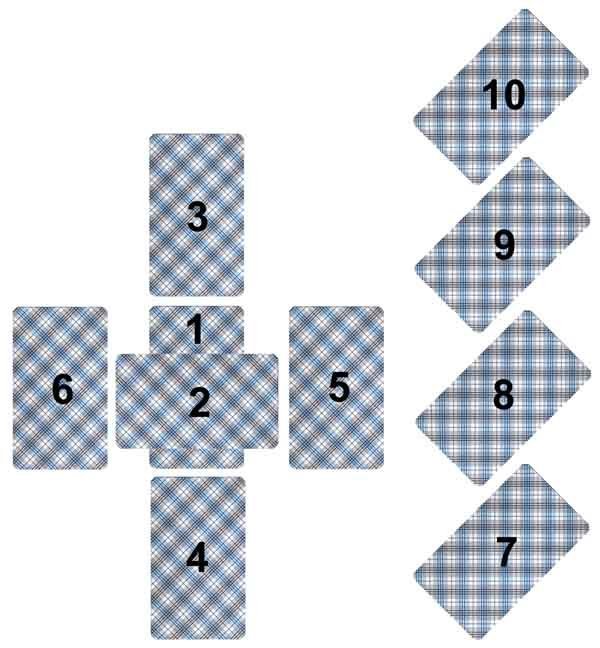
The Most Popular Divination Card SpreadThere are many different spreads used for divination with the Tarot cards, but the most popular one is the Celtic Cross, with ten cards from the Tarot deck in the positions shown on the image above. I recommend it, too. The Celtic Cross sheds plenty of light to any question.
How to Make the Celtic Cross SpreadWhen you use the Tarot Celtic Cross for divination, make sure that you're quite aware of the meaning of each card position in the spread before you start. Otherwise, the result will be rather confusing.You can make the Celtic Cross Tarot divination all on your own, or you can do it for somebody else. In any case, consider carefully who or what the Celtic Cross is for. If it' snot just the person in front of you, or yourself in general, you may want to write down what it is, exactly, that you intend to divine with the Celtic Cross. After the Tarot deck has been shuffled and cut a few times, lay down the cards in the Celtic Cross assigned order (see the image above), which is also the order in which to turn and read the Tarot cards.
Celtic Cross Card MeaningsHere's what each card in the Celtic Cross represents (for the positions of the cards in the spread, see the image above):
Things to Think About with the Celtic CrossWhen you try the Celtic Cross or any other Tarot card spread, it's important that you have a question in mind beforehand. Write it down before starting the Tarot spread, so that you have no doubts as to what you really asked. It will help you tremendously in understanding the answer the Tarot gives.If you don't have a question, the Celtic Cross spread will tell you about your present situation in general and the significant things in its past and future. The Tarot cards of the Celtic Cross will sort of choose what's important for you to consider at this point in your life. That's a good way of discovering the question you should have asked, if you had been consciously aware of it. We don't always know ourselves that well, but we snap it when we get a glimpse of it. As for the meaning of each card position in the Celtic Cross above, you do well to ponder them before trying it the first time — and again for each Celtic Cross card position before turning the card and watching its image. If you do this properly, the card's image will give an immediate response that you grasp intuitively, which is always the best way. My explanations above of the meanings of the ten card positions of the Celtic Cross are not exactly the same as what you find in other books and websites about the Tarot Celtic Cross. They all differ slightly. I've tried to make it as clear as possible, so that you have no doubt about the meaning of a card when you turn it. You may prefer other definitions of the ten Celtic Cross positions, and that's fine. The important thing is that you're clear about it before you start a Celtic Cross spread. Then you can invent your completely own system, and it will work fine for you — the better the more you are aware of the meaning you ascribe to each card position of the Celtic Cross. That's how it works. You decide, and then you do. If you're undecided, you'll have trouble understanding the result properly. When you have decided, it doesn't matter if that's far away from any common Tarot Celtic Cross application. You'll make it work and it will have something valuable to say to you. Therefore, when making the Celtic Cross, don't worry much about rules on how to shuffle and how many times to cut the deck. That's just ritual. The important thing is that you are aware of what you're doing and how you intend to interpret the result. The Tarot Celtic Cross will adapt.
Reversed Cards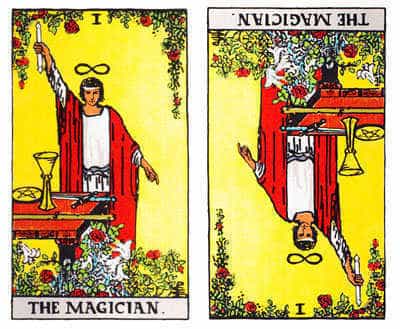 The Tarot card of the Magician, regular and reversed.
It's common with practitioners of a system of divination, such as the Tarot Celtic Cross, to make it overly complicated in an effort to make it say more. Usually, what it says to begin with is quite enough, if pondered properly. Having additional meanings to the Celtic Cross depending on what way a card is facing doubles the information, but doesn't necessarily clarify it. Regular playing cards are usually designed so that there's no upside-down. They look the same both ways. So, people who use such cards for divination make no difference depending on the angle of the card — since it's just not possible. With many Tarot cards it is, at least if they have elaborate pictures covering their surface. But that's far from all Tarot cards. The Marseille Tarot card deck from the 15th century, which is significantly older than the Rider-Waite one, has got many cards that look pretty much or completely the same reversed.
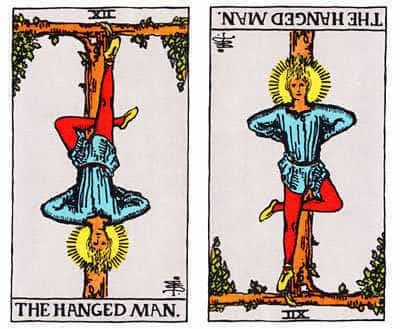 The Rider-Waite Hanged man card, regular and reversed.
Usually, divination by the Tarot is done by someone for another, who sits at the opposite side of the table. So, what's reversed for one is regular for the other. Confusion ensues. My main objection, though, is that the opposite meanings of a card are already in the image itself and included in the assigned meaning to it. Simply put, any situation has a positive and negative side to it, so there's always the possibility of both.
A. E. Waite, the author of the Rider-Waite Tarot card deck, instructed in different Celtic Cross readings for cards in regular or reversed positions. It makes some sense on his deck, but I would still say that it should be considered carefully before being applied to the Celtic Cross reading, or that of any other Tarot spread. If you're comfortable with it when making the Celtic Spread, then by all means go right ahead. But otherwise, watch the images on the cards of the Celtic Cross spread, let your intuition guide you to the meaning regarding the specific question and situation, and don't worry about its angle when you turn it. That also spares you the trouble of figuring out how to flip the cards — from one of its sides or from the top or bottom.
A. E. Waite's Text on the Celtic CrossAn Ancient Celtic Method of Divination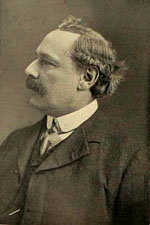 This mode of divination is the most suitable for obtaining an answer to a definite question. The Diviner first selects a card to represent the person or, matter about which inquiry is made. This card is called the Significator. Should he wish to ascertain something in connexion with himself he takes the one which corresponds to his personal description. A Knight should be chosen as the Significator if the subject of inquiry is a man of forty years old and upward; a King should be chosen for any male who is under that age a Queen for a woman who is over forty years and a Page for any female of less age.
This mode of divination is the most suitable for obtaining an answer to a definite question. The Diviner first selects a card to represent the person or, matter about which inquiry is made. This card is called the Significator. Should he wish to ascertain something in connexion with himself he takes the one which corresponds to his personal description. A Knight should be chosen as the Significator if the subject of inquiry is a man of forty years old and upward; a King should be chosen for any male who is under that age a Queen for a woman who is over forty years and a Page for any female of less age.The four Court Cards in Wands represent very fair people, with yellow or auburn hair, fair complexion and blue eyes. The Court Cards in Cups signify people with light brown or dull fair hair and grey or blue eyes. Those in Swords stand for people having hazel or grey eyes, dark brown hair and dull complexion. Lastly, the Court Cards in Pentacles are referred to persons with very dark brown or black hair, dark eyes and sallow or swarthy complexions. These allocations are subject, however, to the following reserve, which will prevent them being taken too conventionally. You can be guided on occasion by the known temperament of a person; one who is exceedingly dark may be very energetic, and would be better represented by a Sword card than a Pentacle. On the other hand, a very fair subject who is indolent and lethargic should be referred to Cups rather than to Wands. If it is more convenient for the purpose of a divination to take as the Significator the matter about which inquiry is to be made, that Trump or small card should be selected which has a meaning corresponding to the matter. Let it be supposed that the question is: Will a lawsuit be necessary? In this case, take the Trump No. 11, or justice, as the Significator. This has reference to legal affairs. But if the question is: Shall I be successful in my lawsuit? one of the Court Cards must be chosen as the Significator. Subsequently, consecutive divinations may be performed to ascertain the course of the process itself and its result to each of the parties concerned. Having selected the Significator, place it on the table, face upwards. Then shuffle and cut the rest of the pack three times, keeping the faces of the cards downwards. Turn up the top or FIRST CARD of the pack; cover the Significator with it, and say: This covers him. This card gives the influence which is affecting the person or matter of inquiry generally, the atmosphere of it in which the other currents work. Turn up the SECOND CARD and lay it across the FIRST, saying: This crosses him. It shews the nature of the obstacles in the matter. If it is a favourable card, the opposing forces will not be serious, or it may indicate that something good in itself will not be productive of good in the particular connexion. Turn up the THIRD CARD; place it above the Significator, and say: This crowns him. It represents (a) the Querent's aim or ideal in the matter; (b) the best that can be achieved under the circumstances, but that which has not yet been made actual. Turn up the FOURTH CARD; place it below the Significator, and say: This is beneath him. It shews the foundation or basis of the matter, that which has already passed into actuality and which the Significator has made his own. Turn up the FIFTH CARD; place it on the side of the Significator from which he is looking, and say: This is behind him. It gives the influence that is just passed, or is now passing away. N.B. — If the Significator is a Trump or any small card that cannot be said to face either way, the Diviner must decide before beginning the operation which side he will take it as facing. Turn up the SIXTH CARD; place it on the side that the Significator is facing, and say: This is before him. It shews the influence that is coming into action and will operate in the near future. The cards are now disposed in the form of a cross, the Significator — covered by the First Card — being in the centre. The next four cards are turned up in succession and placed one above the other in a line, on the right hand side of the cross. The first of these, or the SEVENTH CARD of the operation, signifies himself — that is, the Significator — whether person or thing-and shews its position or attitude in the circumstances. The EIGHTH CARD signifies his house, that is, his environment and the tendencies at work therein which have an effect on the matter — for instance, his position in life, the influence of immediate friends, and so forth. The NINTH CARD gives his hopes or fears in the matter. The TENTH is what will come, the final result, the culmination which is brought about by the influences shewn by the other cards that have been turned up in the divination. It is on this card that the Diviner should especially concentrate his intuitive faculties and his memory in respect of the official divinatory meanings attached thereto. It should embody whatsoever you may have divined from the other cards on the table, including the Significator itself and concerning him or it, not excepting such lights upon higher significance as might fall like sparks from heaven if the card which serves for the oracle, the card for reading, should happen to be a Trump Major. The operation is now completed; but should it happen that the last card is of a dubious nature, from which no final decision can be drawn, or which does not appear to indicate the ultimate conclusion of the affair, it may be well to repeat the operation, taking in this case the Tenth Card as the Significator, instead of the one previously used. The pack must be again shuffled and cut three times and the first ten cards laid out as before. By this a more detailed account of "What will come" may be obtained. If in any divination the Tenth Card should be a Court Card, it shews that the subject of the divination falls ultimately into the hands of a person represented by that card, and its end depends mainly on him. In this event also it is useful to take the Court Card in question as the Significator in a fresh operation, and discover what is the nature of his influence in the matter and to what issue he will bring it. Great facility may be obtained by this method in a comparatively short time, allowance being always made for the gifts of the operator-that is to say, his faculty of insight, latent or developed-and it has the special advantage of being free from all complications. I here append a diagram of the cards as laid out in this mode of divination. The Significator is here facing to the left.
The Significator
About Cookies
My Other Websites:I Ching OnlineThe 64 hexagrams of the Chinese classic I Ching and what they mean in divination. Free online reading.
Complete HoroscopeHow predictions are done in classical astrology with the full horoscope chart. Many examples.
Creation MythsCreation stories from around the world, and the ancient beliefs about the world and the gods as revealed by the myths.
Other Books of MineClick the image to see the book (and Kindle ebook) at Amazon (paid link).
|
 Tarot Unfolded
Tarot Unfolded
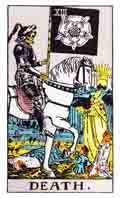 Even the dreaded card Death of the Major Arcana can mean putting an end to something and thereby breaking completely free of it. Death is the Reaper, but also in many cases a liberator. The Tower card indicates some kind of catastrophe, but as horrible as it sounds, that too can be cleansing, opening up for a new solution on which everyone involved gains. And so on.
Even the dreaded card Death of the Major Arcana can mean putting an end to something and thereby breaking completely free of it. Death is the Reaper, but also in many cases a liberator. The Tower card indicates some kind of catastrophe, but as horrible as it sounds, that too can be cleansing, opening up for a new solution on which everyone involved gains. And so on.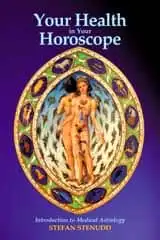


 Stefan Stenudd
Stefan Stenudd